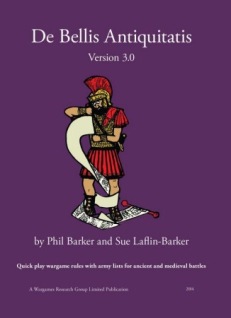Last Friday my copy of De Bellis Antiquitatis 3.0 (DBA) arrived from Black Hat Miniatures in the UK. It must be said it was with some anticipation that I opened the parcel, for despite having a role in the play testing group, and seeing many of the restricted drafts, the final printed package was still a little of an unknown.
As mentioned in a previous post, the rules come as a hardcover of 144 pages including an internal cover and contents page. The format is A4 and the pages are of good quality glossy paper. The binding is of very good quality. The font is very readable, without excessive size, with good line spacing. These are all significant changes to previous versions of DBA.
Following an introduction and design philosophy section the rules start on page two with table definitions and an outline of scales. Troop definitions now comprise two pages before a single page covers basing. Of note optional basing has been included providing increased base depth for close formation foot, useful as many figures are more animated.
The rules themselves cover seven pages. There are a number of changes here, yet they retain the standard DBA mechanics. I won’t try and describe them all here however, some of the most significant include:
- Additional terrain types such as ploughed fields, gullies, rough going and a range of built up areas to provide more variety.
- A revised terrain placement system producing a less player customised battlefield which enhances the game.
- Deployment changes to encourage historical troop deployment.
- Larger moves, defined in base widths, to encourage more dynamic play.
- Changes in rear rank support to provide greater consistency with historical depths.
- An introduction of solid and fast ratings to better model the differences between some troops. In combat situations this only comes in to play on tied results so is relatively minor but adds some additional interest and colour.
- Rules to remove geometrical ploys.
- Revised threat zones to requiring greater consideration of reserves.
- The introduction of allies into basic 12 element armies.
Clearly there are some changes, which I feel are enhancements, yet the rules are still going to be familiar to players of previous versions. A two page section follows and covers larger DBA games or suggestions on how to use the rules for refighting historical battles.
A major addition to the usability of the rules is a greatly expanded and enhanced section of diagrams. There are now 16 pages of diagrams with each page generally having three or four clear, and well explained, diagrams per page. This section will be useful for existing and new DBA players.
A significant upgrade to the DBA 3.0 rule book is the large expansion of the army lists section. Each of the 300+ army lists now has a background section which outlines the historical army. Typically this includes a potted history of the army. Some descriptions are short, while others run to a third of an A4 page or more. Included with each list is a section on references. These are primarily historical, but in some cases a fictional reference is included for the army. This provides interesting reading to both new and veteran gamers. Many lists are further divided into sub lists with all having a brief, but clear, description of the troops forming the army. This useful feature will greatly assist players looking to build armies. All up the army list section covers over 100 pages. Finally, this section is supported by a further seven pages of army list cross references and alphabetical indexes to the lists.
In my view DBA 3.0 is, without doubt, an outstanding package with a significant increase in presentation and clarity. While the rules are still simple the package, especially with the diagrams and army lists, will assist existing and future gamers considerably.
Copies can be purchased from a range of suppliers including, but not limited to: Black Hat Miniatures in the UK; Amazon UK; On Military Matters in the US; and Olympian Games in Australia.

Great review. Have you considered posting it to Amazon?
No, I hadn’t considered Amazon actually.
Great review Keith 🙂
Great review. I was astounded by the whole package of rules diagrams and the lists. All in all worth the wait
Good review, I agree about all the statements
Thanks for the review. I’ve been contemplating getting 3.0; I previously played 2 and 2.2(?).
Are the rules easier to read? Barkerese can be rather daunting…
Phil Barker’s style of writing remains in the body of the rules, with some softening in places driven by feedback from the play test group. The diagrams, and the associated explanations, however greatly ease understanding. I believe they will be well liked.
I concur. The DBMM 2.0 rules are also much easier to comprehend. By writing DBA 3.0 in simple language the hobby is more accessible to younger players. I doubt kids these days have the patience for Avalon Hill games. You have to appeal to the masses.